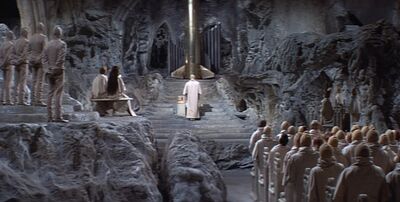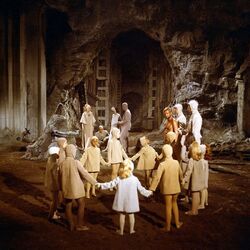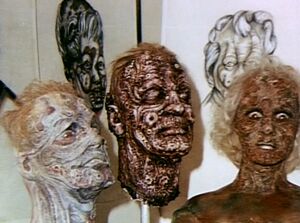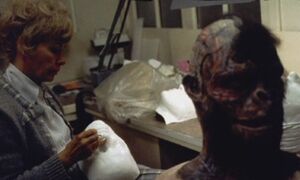- "Glory be to the Bomb, and to the Holy Fallout. As it was in the beginning, is now, and ever shall be. World without end. Amen."
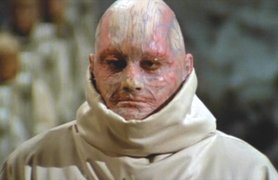
Mutant leader Mendez XXVI from
Beneath the Planet of the Apes
A Mutant represents any biological organism whose physical hereditary characteristics have been altered from that of the parent organism. Such alterations occur on the genetic level and may lead to further unpredictable mutations depending upon the initial root cause as well as other external stimuli. In terms of Beneath the Planet of the Apes, a mutant is a distorted creature marred by the radiation levels remaining after the nuclear war that destroyed much of life on Earth as seen in Planet of the Apes. Some are bestial and some are brainy. They generally live in the Forbidden Zone and do not seem to be very nice. [1] The community of telepathic mutant humans encountered by Taylor and Brent in Beneath the Planet of the Apes lived in the ruins of New York City and worshiped the ultimate nuclear weapon - the instrument of the planet's final destruction.
Beneath the Planet of the Apes[]
History[]
The mutants were descended from a long line of mutated humans, whose origins dated back to the 1990's when the human controlled governments of Earth waged war with one another – a war which devastated significant parts of the population, and caused drastic geological upheaval.
Survivors of the nuclear holocaust were forced to seek shelter in the ruins of cities contaminated with atomic radiation. The exposure to this radiation caused severe genetic defects – defects which were passed down through the generations, forcing select groups of mankind to evolve into a new subspecies of mutant. Two-thousand years later, many of these mutant descendants began to develop advanced telepathic abilities. Whether these mental endowments were borne as a side-effect of their mutation is still a matter of speculation.
By the late 40th century, a coalition of mutants established a settlement in the ruins of St. Patrick's Cathedral in New York City. They had acquired a weapon of mass destruction – a surviving relic from Humanity’s downfall. This was a Doomsday device known as the Alpha-Omega Bomb. Declaring the weapon as the "Divine Bomb", the Alpha-Omega Bomb represented not only a unifying characteristic of their lifestyle, but of their origins as well. They believed that God spoke to them through the weapon. They placed the missile, as well as its accompanying launch controls, at the nave of their altar in the cathedral. On most occasions, the subterranean denizens of New York wore latex masks and wigs which concealed their physical mutations, but during liturgical services and Mass, it was customary to remove their masks while proclaiming in unison, "I reveal my Inmost Self unto my God."
All elements of mutant culture revolved around devotion towards their religion. Followers wore stark, white, full-bodied uniforms, the design of which was patterned after the protective radiation suits worn by their ancestors. Even children were expected to behave in accordance to the tenets of their faith. A popular children's nursery rhyme, though seemingly innocent, invoked images of the nuclear horror that befell mankind centuries past. [2]
- Ring-a-ring o'neutrons,
- A pocketful of positrons,
- A fission! A fission!
- We all fall down.
The mutants were reclusive isolationists who shied away from the world above them. However, in 3978, a time-lost astronaut named George Taylor stumbled upon their underground society. The leaders used their mental powers to interrogate him at length, from which they learned that a society of evolved apes had developed a community outside the ruins of New York City. After extracting as much information as they could from Taylor, they imprisoned him in one of their many dungeon cells.
On occasion, the reigning council from Ape City would send Gorilla scouts into the region (which they referred to as the Forbidden Zone), in search of evidence of human occupation. To protect themselves from inquiry, the mutants used their telepathic powers to create massive illusions depicting scenes of graphic violence. In some cases they would craft the image of a great wall of flame; in others they would produce visions of apes being crucified and tortured. On one circumstance, they allowed a gorilla scout to enter the underground tunnels, where they placed him under an intense telepathic interrogation. Recognizing the aggressive prejudices of the apes, they decided that apes were a threat to their existence and took elaborate measures to conceal themselves from further inspection.
A short time later, another astronaut named John Brent and a mute human named Nova followed Taylor's trail into the Forbidden Zone. [3] The mutants captured them, and used the same mental torture techniques against Brent and Nova that they had used upon Taylor. They even manipulated Brent into turning on Nova, forcing him to choke her nearly to the point of death. After gleaning any information of value from him, they placed Brent into the same cell as Colonel Taylor. A guard named Ongaro watched over the prisoners and used his mental powers to make them fight against one another. In keeping with the structure of their own Holy doctrine, Ongaro iterated the fact that they do not actually kill their enemies, but rather, they force their enemies to kill each other. Brent and Taylor managed to break free of the mind control however, and killed Ongaro while escaping from their cell.
At the same time, a gorilla military leader named General Ursus led an invasion party into the Forbidden City to route out and exterminate all human occupants. They found the mutant’s cathedral and proceeded to execute as many mutants as they could find. Mendez and Caspay along with an unknown female mutant were shot down in cold blood, while Albina preferred to end her own life rather than suffer the fury of a military onslaught.
Moments after the last of the mutant leaders were executed, George Taylor, dying from a gunshot wound, fell upon the launch controls of the Alpha-Omega Bomb. The device was activated and the resulting explosion destroyed the entire world and killed any surviving mutants that weren't executed by Ursus' Gorilla soldiers.
Psychic Abilities[]
Members of the mutant leadership (notably the Inquisitors) possessed a wide variety of psychic abilities. These powers included the ability to communicate telepathically with their fellow mutants, as well as other humans. They employed these powers for a variety of effects, which they referred to as "Weapons of Peace". The most common of these abilities was a process known as the Visual Deterrent. This reflected a mutant's ability to create elaborate and convincing illusions designed to confound or in some cases ensnare unsuspecting prey. They used the Visual Deterrent to trap the time-lost astronaut George Taylor. They later used the power to much broader effect in the hopes of warding off an encroaching ape army. Accompanying the Visual Deterrent was a practice known as the Sonic Deterrent. Using this technique, a mutant could generate a piercing sonic hum in a target's mind – the intent of which was ultimately to drive the victim insane. The most intrusive and devastating tactic however, was a practice called Traumatic Hypnosis. Using this ability, a mutant could control another person's mind, forcing them to act in contrast to their own nature – even violently.
Notes[]
- The mutants' name for the own society was never indicated on film or in the script. Marvel's comic book adaptation of the film, however, identified the mutants as the 'Children of the Bomb'.
- In Paul Dehn's earliest outline for Beneath the Planet of the Apes - the first of his story arc - he had already mapped out the background of the Mutant society: Their hereditary leader, Mendez the twenty-sixth, never tires of telling them that this religion is the first in Earth's history to have been founded not on Faith but on Fact. And this, in a sense, is true. When the last Atom Bomb exploded in up-state New York (circ. 1995) and huge earth-subsidences buried New York City, the few thousand survivors on the surface went underground in the hope of avoiding or at least minimising the genetic effects of radioactivity. It took only the misshapen birth of the next generation for this hope to be proved false. The mutants were 'created by the Holy Fall-Out descending like manna from the Divine Bomb'.[4]
- In the movie, the character of Mendez XXVI is credited only as "Mendez". The novelization indicates that he is the twenty-sixth Mendez in a line of succession.
- Natalie Trundy, who played the mutant Albina, returned to the franchise first as Stephanie Branton in Escape from the Planet of the Apes, then as the chimpanzee Lisa for Conquest of the Planet of the Apes and Battle for the Planet of the Apes.
- Actor Don Pedro Colley is credited only as "Negro" in the closing credits of the film. Colley's official web-site lists his character's name as Ongaro[5]
- The site of Brent's interrogation was Grand Central Terminal.
- Originally the music for the mutant's liturgy was to be composed by Jerry Goldsmith, who scored the music for the first Planet of the Apes film, but POTA director Frank Shaffner convinced the studio heads at Twentieth Century Fox to pull Goldsmith from the project in favor of having him score Shaffner's then current film project, Patton. Goldsmith was ultimately replaced with composer Leonard Rosenman. [6]
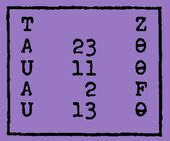
"Mendez raises great, hooded eagle eyes to his recess. Projected in purple, the four Inquisitors nod their understanding of the image's implication."
(Technical advice may well yield a mathematically more apposite 'projection' than this computer-code instruction for calculating the time/space continuum of an approaching astral body. I stole it from the astronomer, Hoyle) - Paul Dehn, Planet of the Apes Revisited - First Draft Screenplay
- All of the elder members of the mutant community wore liturgical vestments, which were color-coordinated with the visual effects of their thought projection abilities.
- Mendez XXVI - Purple
- Ongaro - Yellow
- Caspay - Turquoise
- Adiposo - Red
- Albina - Blue
- The first draft screenplay listed the areas of concern for each of Brent's Inquisitors. "Our actors should note that each Inquisitor pursues (in alternation) an individual line of questioning.
- The Negro probes for facts;
- Albina, for emotional feelings;
- Caspay, for beliefs and opinions.
- The Fat Man asks no questions at all. He is there merely to induce pain.[7]
- The final screenplay reversed two of those roles.
- The Fat Man probes for facts.
- The Negro asks no questions at all. He is there merely to induce pain.[8]
- According to The Mutant News newspaper distributed in theatres showing the movie in 1970, the leader of the mutant resistance to the ape invasion - the 'General of the Defence' - was 'Ygli VII', whose responsibility was to train the population in the use of mental deterrents.[9]The purpose of the deterrent is to prevent any injury whatsoever to non-apes. If the deterrent was ignored then the process of AD would begin. AD stands for Assured Destruction.
Behind The Scenes[]
Beneath the Planet of the Apes screenwriter Paul Dehn first developed the idea of the mutants. He conceived a grotesquely misshapen race who took pride in their deformities, and in his very earliest treatment introduced Mendez XXVI - "a figure who looks like the Grand Inquisitor grotesquely lengthened by a distorting-mirror. The immensely tall, cadaverously lean body is topped by a head discernibly human, though the great aquiline nose suggests an eagle's beak. Even the long fingers are raptorially curved like claws. But the eagle seems blind. Where there should be eyes, there is facial flesh. Then a curious thing happens. Mendez says: 'Let me look at you' and turns slowly into profile to reveal that his eyes are at the sides of his face and not in front. He can, like a great bird, look outwards but not forwards." The evolution of the mutants was to be demonstrated visually, with an example of their hypocrisy: "Mendez... enters a long corridor, lined with statues, ...they are strictly representational, totally realistic statues of Mutants; and the names and dates on the plinths tell us that they are Mendez's ancestors... as the dates become earlier, each statue's appearance approximates closer to the human norm... We end on Mendez I - a normal, handsome, strong-jawed, military-moustached, grizzle-haired soldier... Mendez pauses for a moment - seeing (without turning) out of his side-eye - and whispers in a sort of agony: 'Forefather, why can we not all look like you?... From whom will come the new, untainted blood that should cleanse our inbred race? We have lived a thousand years alone, like worms, below ground - doing good to none but ourselves. If we come up to Earth's surface we shall die. And though my people have been taught (for their greater comfort) that they are beautiful and therefore to be desired, what stranger, coming down among us, would find us desirable enough to use our deviant bodies for the creation of a nobler breed? Forefather, why can we not all look like you?'"[10]
Dehn altered his vision of the mutant deformities for his later screenplay, keeping the idea of their gradual deterioration, but lessening the effects on their physiognomy. "At first, we were going to have them really mutated with monstrous noses and three eyes, real horror figures, but we didn't think that would have been nice for the children and after a great deal of research, it was the makeup department that came up with the idea that if you had been radiated, all seven layers of your skin would have been destroyed, and all that would be left was this terrible network of veins."[11]
Director Ted Post was apparently responsible for the final makeup concept for the mutants in the film. For many months, the studio had spent thousands of dollars and several artists trying to find the right look for the mutants, coming up with almost every conceivable brand of monstrosity, deformity, and what-have-you. When Post walked into the makeup lab, he was appalled at the sight of myriad grotesque plaster heads lining the shelves, ranging from early Universal to early American-International in appearance. He remembered a drawing from a medical text entitled 'Gray's Anatomy', in which was printed a vivid picture of a man's head, with the top layer of epidermis removed. For some reason, he never forgot that picture and suggested the idea to Dan Striepeke and John Chambers. With the magic of their skills, they transformed this into film reality.[12]
In order to create the effect of a human being mutated through exposure to radiation, make-up artist Chambers examined photographs of corpses where the outer dermal layer of skin had been removed. After sifting through other, more graphic potential mutant designs, he decided upon using these photographs for the basis of his mutant make-up. [13] He later recalled: "This was a full, soft foam-rubber head appliance, and I used silicone adhesives to blend it out. In the ape appliances, there were small pieces, a chin, a muzzle, and a forehead, and the rest was face hair and a wig. It took more time to blend the edges there, but the mutants were already made up, and the only extra makeup we used was around the eyes and mouth. So we took two hours, average, on those."[14]
The original ending to the movie was to have the competing ape and mutant armies destroyed in the explosion of the missile, while Taylor, Nova and Brent escaped to the Ape City to establish a Utopian society. Moving forward by many decades, the action would cut to the Forbidden Zone where a group of horribly mutated gorillas emerge from a tunnel and, symbolically, shoot a dove.
Battle for the Planet of the Apes[]
With the final movie of the Apes series, writer Paul Dehn wanted to bring the story full-circle and show the lead up to the events of the original movie and Beneath. Thus Battle for the Planet of the Apes shows the remnants of humanity in Governor Breck's city starting to become disfigured and mentally unbalanced due to the fall-out of a nuclear war. They also - in scenes filmed but only added to the film in DVD releases many, many years later - possessed the Alpha-Omega Bomb. Kolp, Chief of Breck's security at the time of Caesar's rebellion, was now the leader of the survivors after Breck's death. His chief advisors were Mendez (presumably 'Mendez I') and Alma, who took on the leadership of what remained after Kolp and his military leader launched a disastrous assault on Caesar's Ape City that resulted in the death of most of the able-bodied mutants and the capture of the few survivors. The final 'lost' scene from the movie showed Mendez refusing to detonate the bomb, preferring to view it as a symbol of hope for a peaceful future.
The scenes deleted from the movie serve to make the series a continuous loop. The reason they were omitted from the final theatrical cut is unknown. It has been speculated that they were omitted so that the ending could be left open - that the nuclear obliteration of the planet was not inevitable. However, according to Paul Dehn, the final shot of a tear on Caesar's statue was to tell the audience that Caesar's efforts would ultimately fail.
Planet of the Apes Magazine[]
The Planet of the Apes Magazine published by Marvel Comics between 1974 and 1977 featured comic-strip adaptations of the five Apes movies, with the mutants as outlined above. One significant change was that, working from the shooting script rather than from the final cut of the movie, the adaptation of Battle featured Breck as the now-mutated leader of the humans in place of Kolp, and the strip also included the 'Alpha-Omega' scenes which were edited out of the theatrical release.
The new, original stories included in the magazine, written by Doug Moench, were full of wildly imaginative scenarios far beyond what was depicted in the movies or the TV series. In Terror on the Planet of the Apes, for example, the fugitives Jason and Alex had to combat giant mutated river monsters while on their way to confront 'The Inheritors', the society of vaguely-human Mutant Drones controlled by a network of five huge disembodied brains suspended in glass cases. The Inheritors also kept a menagerie of mutated monsters which they used for pit-fighting for their entertainment. The Inheritors had a rival race of mutant human descendents known as 'The Makers'. The Makers were slightly more human in appearance, though they were extensively reconstructed with bionic replacement body-parts. They were also more paranoid, and therefore destructive, than the power-hungry but calculating Inheritors. How their races diverged and became sworn enemies is not revealed. A race of Winged Monkey-Demons served the stranded alien 'Keepers' in their vast, buried ship - the 'Psychedrome'. The origin of the Monkey-Demons isn't known, whether they were fellow-aliens or Earthly mutations.
Evolution's Nightmare told the tale of the one human and one ape survivors of a great war, who had to travel together in order to escape the Forbidden Zone. Along the way they encountered monstrously deformed beasts, and their story ended when they were killed in the crossfire of two competing gangs of Mutant Apes and Mutant Men in the ruins of a destroyed city. Kingdom on an Island of the Apes included a knight's quest against a 'dragon' - a giant lizard, mutated to enormous size. Future History Chronicles rivaled Terror for it's inventive script. The sea-faring heroes had to deal with giant sea-monsters, one of them genetically engineered by an orangutan, before they encountered the 'New Order Born Of Old Sins' - a sea-borne population of horribly mutated apes and humans who traveled with a nuclear missile onboard their ship increasing their mutation constantly. They had differing views on how their 'New Order' had originated, but agreed that the effects of the radiation made them all so disfigured as to make any conflict between their species pointless. Their twisted logic was to spread their radioactive mutation to every living creature. Seemingly sinking the mutant's ship, the heroes later found themselves at the mercy of mutant apes who traveled on giant mutated frogs.
Return to the Planet of the Apes[]
The Return to the Planet of the Apes animated series borrowed heavily from both the movies and the live-action TV series, whilst also adding it's own flavour. One such example was the 'Underdwellers'. These humans - entirely distinct from the mute humans of Nova's tribe - resembled the mutants of Beneath the Planet of the Apes in their robed attire, their apparent psychic and telekenetic powers (in making Judy disappear into a fissure in the ground in episode one; teleporting her back when she tried to escape), and their living in the underground ruins of a human city. They were not shown to be mutated beneath their human appearance however, and while they were single-minded in their self-preservation, they were not as outwardly hostile as the mutants of Beneath. In addition, they seemed to live in very close proximity to the Ape City, perhaps even directly below it, and their presence there was common knowledge - Urko attempted to provoke a war with them by sending hooded gorillas to commit robberies disguised as Underdwellers. Their leader was Krador, and their religion was centered on what they believed to be a statue of a prophesised saviour called 'Usa' - in reality a statue commemorating the lost astronaut Judy, with the letters 'U-S-A' noting her nationality. This was why they had abducted their 'saviour' when she suddenly appeared from the sky.
Adventure Comics' Planet of the Apes[]
The Adventure Comics' series of Planet of the Apes comics and spin-off comics dealt with as wide a span of Apes history as did the Marvel Comics line. The title comic series featured a tribe of 'Children of the Forgotten Apes' led by Dunzell - forgotten because they had been imprisoned in underground cells within the Ape Management building, and had been left there unbeknownst to Caesar's rebellious ape followers. Trapped and kept prisoners by the mutated humans left in the city, they too had become mutated, and developed psychic powers. They were given their freedom by Caesar, but met their deaths at the ghostly hands of the spirit of Governor Breck - revived by those same mutated human survivors. His first act, however, was to slaughter the disfigured examples of humanity who had brought him back into existence.
The Forbidden Zone mini-series set out a dispute amongst the mutant community which led to Mendez X being expelled by Kolp (a different Kolp) and finding a new home in the ape/human settlement called 'Primacy'.
BOOM! Studios' Planet of the Apes[]
In BOOM! Studios' principal Planet of the Apes title there were no mutants featured as such, but there was a religious order led by Brother Kale and Sister Martha who, we are told, separated from a main body of missile-worshippers taking with them a small part of their arsenal. Kale set up a mission among the human population of Mak, where he had a particular following among the younger mutes. Kale and his order were all bald or shaven headed, they wore robes very similar to those worn by the mutants in Beneath the Planet of the Apes, they had telepathic abilities, and they actively organised armed resistance to apekind, but they did not appear to be physically mutated or wearing masks.
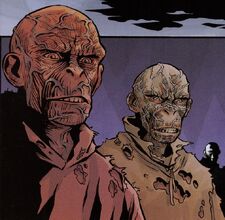
Mutant chimps
BOOM!'s parallel storyline continuity stretched through Betrayal of the Planet of the Apes, Exile on the Planet of the Apes and Planet of the Apes: Cataclysm and portrayed Ape City in the years before Taylor's arrival. In Planet of the Apes: Cataclysm we learned that the mutants who guarded the Alpha-Omega Bomb had an extremist faction within their midst who wished to fire the weapon and end the world. To this end, one of their number murdered the chimp monk Brother Corvin and used his identity to access an ancient missile base, firing, and destroying the Moon. He then headed to Ape City to cause further damage before his identity was revealed to Zaius and he was killed. At some point, Ursus apparently either became their agent, or was himself a mutant in disguise. Later, Milo was captured by these mutants but was helped to escape by a member of the pacifist faction, who also summoned Zira, Cornelius and Lucius to join Milo after he had repaired Taylor's spaceship. Before that, however, Milo and Cornelius travelled to the distant Painted Valley, where they discovered a group of chimpanzees mutated by water contaminated by the nearby Forbidden Zone. These mutant apes had the ability to project mental images such as monsters, but they were only just learning to control their powers and were eventually received back into the remote community from which they had been outcast.
See Also[]
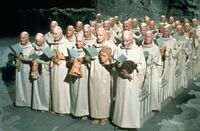
The Mutant Congregation from Beneath the Planet of the Apes
- Adiposo
- Albina
- Alma
- Alpha-Omega Bomb
- Breck
- Caspay
- Fellowship of the Holy Fallout
- The Forgotten Apes
- The Inheritors
- Jaekel
- Karno
- Kolp
- Kolp (Malibu Graphics)
- Krador/ The Underdwellers
- Ongaro
- The Makers
- Mendez
- Mendez I
- Mendez II
- Mendez Ten
- Mendez XI
- Mendez XII
- Mendez XIV
- Mendez
- Mendez XXVI
- Mendez Dynasty
- Mutant Workers
- Mutant Captain
- Mutant on Motorcycle
- Mutant Apes
- Mutant Men
- Mutant Drones
External Links[]
- Mutant article at Wikipedia
- Mutant (fictional) article at Wikipedia
- Mutant (Marvel Comics) article at Wikipedia
References[]
- ↑ Glossary to the Planet Of The Apes Jim Whitmore (1976)
- ↑ Although Beneath the Planet of the Apes featured an image of children playing together, the nursery rhyme that they sang was only included in the shooting script, and was not incorporated into the final cut of the film. The nursery rhyme is a re-imagined version of "Ring Around the Rosey".
- ↑ Beneath the Planet of the Apes gives the year as 3955, however this is inconsistent with the timeline provided in the first film. For the sake of consistency, this site recognizes the year 3978 as the authoritative timeline of events for both Planet of the Apes and Beneath the Planet of the Apes.
- ↑ Planet of the Apes Revisited - A treatment at Hunter's Planet of the Apes Scripts Archive
- ↑ The Official Don Pedro Colley Website
- ↑ John O'Callaghan; "The Great Apes Score Debate", Film Score Monthly
- ↑ Planet of the Apes Revisited - First Draft Screenplay at Hunter's Planet of the Apes Scripts Archive
- ↑ Beneath the Planet of the Apes - Final Screenplay at Hunter's Planet of the Apes Scripts Archive
- ↑ 'Beneath the Planet of the Apes' promotional material
- ↑ Planet of the Apes Revisited - A treatment at Hunter's Planet of the Apes Scripts Archive
- ↑ 'Cinefantastique Planet of the Apes Issue' (1972)
- ↑ 'Cinefantastique Planet of the Apes Issue' (1972)
- ↑ Behind the Planet of the Apes; 20th Century Fox, 1998
- ↑ 'Cinefantastique Planet of the Apes Issue' (1972)

